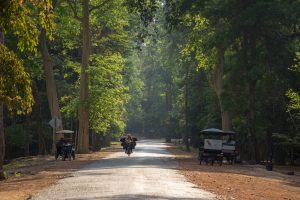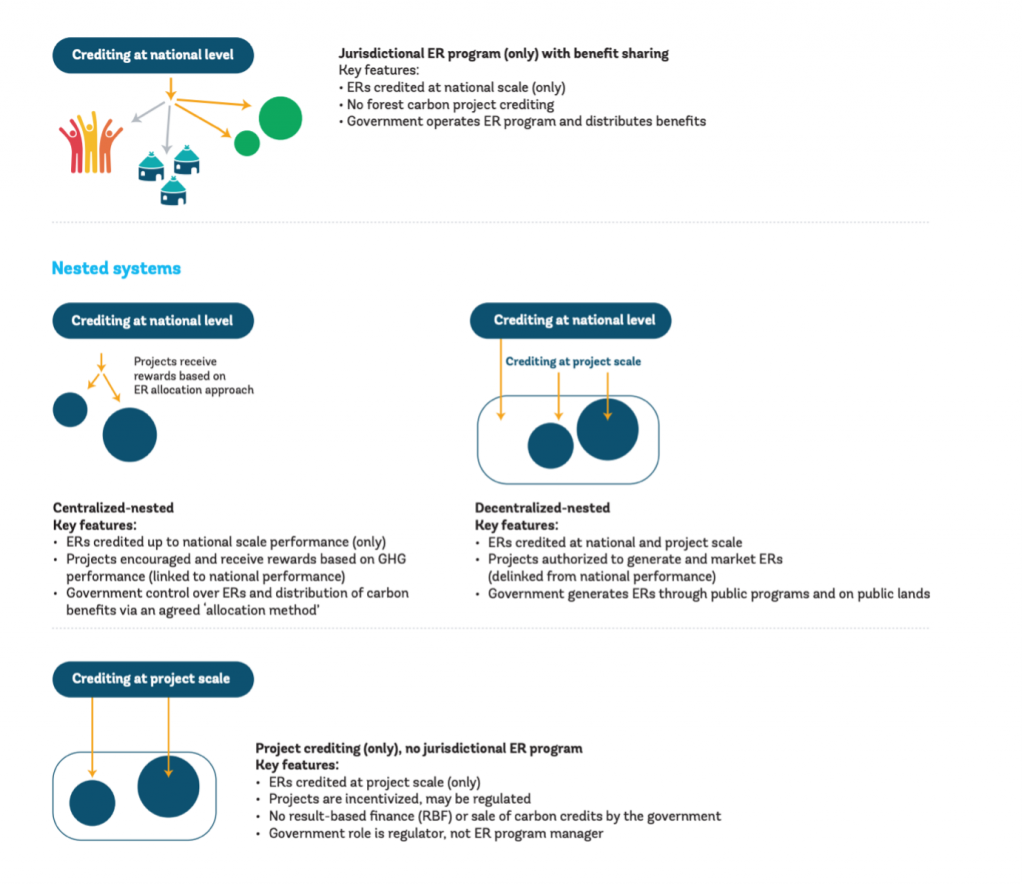Shades of REDD+
Filling an Urgent Need: New Guidance for ‘Nested REDD+’ Published
Over the last months, several companies have announced an aggregate of more than two billion dollars of investments -in particular trading houses or major emitters- in voluntary carbon market projects that champion nature-based solutions. At the same time, the LEAF coalition is encouraging the development of jurisdictional REDD+. For such initiatives to peacefully coexist, there is an urgent need for countries to build “nested” REDD+ systems.

19 October 2021 | The successful implementation of efforts to reduce deforestation and forest degradation (REDD+) depends on a close collaboration of governments, communities, and private entities. Governments have to take the lead in improving legal frameworks and investing in forest governance. Low levels of law enforcement, weak and contested land titles and rampant corruption undermines public goals to reduce and halt deforestation. At the same time, corporations must achieve transparency in their operations and eliminate deforestation from their supply chains. In addition, private investments into projects and programs that reduce forest loss can help to conserve forests at deforestation hotspots. They mobilize emission reductions and removals in a bottom-up, non-state approach to REDD+ that allows the forging of local multi-stakeholder coalitions around conservation.
In a rather unfortunate way, the interests of governments and the private sector around REDD+ have been described as diverging – governments with an interest in monopolizing forest protection despite serious governance challenges and private investors driven to conservation by short-term financial interests. This juxtaposition of interests found its expression in a fierce debate on whether private investments in projects have a role to play in the context of REDD+, backed by mutual suspicion that private or public actors seek to undermine REDD+ accounting frameworks to maximize payments. It is time to bury the hatchet and champion all actors with an interest in protecting the forest.
‘Nested’ REDD+ can help to bring this short-sighted debate to an end and focus the collective attention on halting deforestation.
Nesting is a tool to implement forest conservation strategies, harnessing the financial muscle and implementation capacities of private not-for-profit and for-profit actors while aligning such activities with public policies around REDD+. Well-designed nesting systems align public policies and accounting frameworks with private projects that seek to avoid deforestation. Nesting recognizes the existence of project investments and acknowledges their contribution to realizing the mitigation potential of forests. However, it also appreciates the need for coordinated systems that ensure that REDD+ emission reductions are aligned with policy and conservatively measured. Considering budgetary constraints, policymakers may consider foreign-direct investments in avoided-deforestation or forest restoration projects as one – among several – valid REDD+ financing strategies. A nested system can actively encourage the development of future REDD+ projects and embrace them as a valid, private sector driven mitigation strategy.
However, so far, no fully developed nested system exists. For a reason: developing policy and institutional frameworks for nested REDD+ is no easy feat. It requires taking strategic decisions, while building technical capacities, assessing carbon rights and legal challenges, strengthening institutions, and managing performance risks. A recently released World Bank publication is offering help to policymakers: the “Nesting of REDD+ Initiatives: Manual for Policy Makers” discusses the operational details that need to be considered when implementing a nested REDD+ system.
Over the last 18 months, the authors had the opportunity to support the World Bank on developing practical guidance on how to implement nested REDD+ systems that take into account the different realities of REDD+ countries. Nested REDD+ systems can come in different shapes and forms and can be tailored to different country contexts. They differ in the degree of decentralization of REDD+ implementation and the role that they assign to nonstate actors (private entities, communities, and nongovernmental entities) in conserving and restoring forests. Decentralized REDD+ systems focus on allowing direct investments into projects while harmonizing and integrating accounting methods as well as defining common criteria for safeguards and stakeholder participation. Centralized REDD+ systems seek to achieve REDD+ outcomes primarily through public policies and allowing governments to (exclusively) receive and allocate REDD+ payments through benefit-sharing systems.

After multiple rounds of consultations with government officials, private sector entities, and practitioners working to reduce forest loss in tropical countries, the Nesting Manual presents four general models for REDD+ implementation:
A jurisdictional REDD+ program with no crediting of greenhouse gas (GHG) results at the sub-jurisdictional level. This model relies on the government’s ability to achieve emission reductions via public programs, and to monetize those emission reductions at the jurisdictional level. Local actors contribute by implementing activities defined by the REDD+ program and receive carbon benefits from the government as part of a benefit sharing arrangement.
A REDD+ program with jurisdictional and project-level GHG accounting and government distribution of funds to projects. Under this “centralized nested” model, the government encourages programs and projects and allows for the sharing of emission reductions or equivalent monetary benefits with programs or projects. REDD+ benefits are shared based on GHG performance. However, the rewards for projects depend on jurisdictional performance and government distribution of benefits.
A REDD+ program with jurisdictional and project-level GHG accounting and independent project financing. Under this “decentralized nested” model government allows the crediting and monetization of emission reductions at both the jurisdictional program and project scales. Projects can issue tradable carbon credits that do not depend on jurisdictional performance. In this model, the government can regulate the MRV and safeguards of the projects to ensure that they are in alignment with the national approach.
Finally, governments can define criteria for project crediting without engaging in jurisdictional REDD+. This model does not foresee crediting of emission reductions at the jurisdictional level. Where countries are unable, or do not wish, to develop jurisdictional REDD+ crediting programs, they may still welcome investments in avoided-deforestation projects. In this case, the government may regulate projects, for example, to enhance the environmental integrity of claimed mitigation outcomes from projects, to provide guidance on benefit sharing by projects to ensure vulnerable populations are well served, or to ensure compliance with national safeguards.
The Nesting Manual elaborates on these four models, discussing design elements and ways to operationalize them. It thus enables governments to design nesting systems that are suitable to national circumstances, while ensuring the environmental integrity of mitigation outcomes from forests. A Decision Support Tool accompanies the manual, offering policymakers assistance in building a nested system. The Nesting Manual and Decision Support Tool represent a first attempt at a comprehensive analysis of the different elements that influence the design and implementation of REDD+ nesting. As time goes on, it is expected that the Manual and Decision Support Tool will be enriched with REDD+ nesting experience from different countries.
Nesting is pragmatic and action oriented. It rejects narrowly defined REDD+ implementation approaches and embraces instead a more integrated and holistic view of landscape conservation strategies. The Manual marks a step towards a scaled and multi-layered REDD+ implementation, which will help to conserve tropical forests. It is urgently needed.
—
Additional links in reference to excerpt that references investments “an aggregate of more than two billion dollars”:
Please see our Reprint Guidelines for details on republishing our articles.

